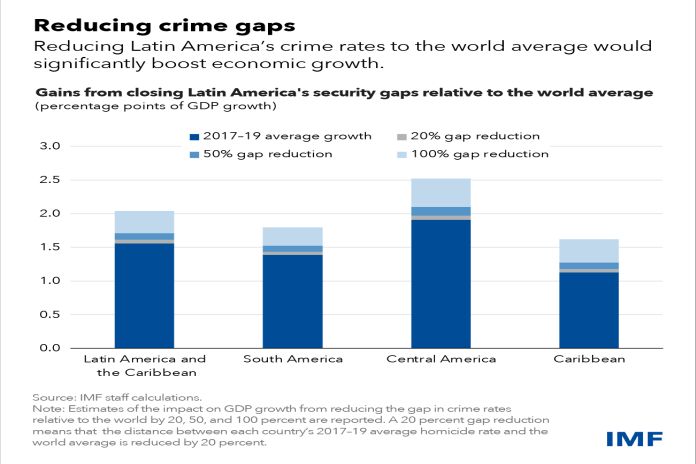– Reducing crime could significantly boost investment, productivity, and GDP growth in Latin America and the Caribbean
By Rafael Machado Parente, Rodrigo Valdes
Crime and violence have long been a top-of-mind concern for households across Latin America and the Caribbean. The region accounts for nearly half of the world’s intentional homicide victims, despite representing just over 8 percent of the global population, United Nations data show.
The average homicide rate in the region is 10 times that of other emerging markets and developing economies and twice as high as sub-Saharan Africa. Within the region, Central America stands out as the most violent subregion. Insecurity has also worsened over time, especially in some parts of the region. For example, Central America and the Caribbean have experienced annual increases in homicide rates of about 4 percent in the last two decades.
Crime directly affects the lives of millions of people and imposes large social costs. Because there is a delicate interplay between economic activity and crime, determining causal effects is not easy. More economic activity will reduce crime, but less crime would, in turn, boost economic activity. Another factor, such as the strength of rule of law, will also affect both.
Our recent study shows that increases in homicide rates significantly reduce economic growth. In Latin America, a 30 percent increase in homicide rates (equivalent to a historical 1 standard deviation) is estimated to reduce growth by 0.14 percentage points. We build on previous IMF work on Central America, Panama, and the Dominican Republic using data on criminal deportations from the US to tease out the causal effect of crime on economic activity.
Our study highlights the different channels through which insecurity affects economic growth. Estimates show that crime hampers capital accumulation, by possibly deterring investors who fear theft and violence, and decreases productivity, as it likely diverts resources toward less productive investments such as home security.
The benefits of reducing violence can be substantial. According to the study, bringing the crime level in Latin America down to the world average would increase the region’s annual economic growth by 0.5 percentage points, about a third of Latin America’s growth between 2017-19. Moreover, confronting insecurity where it is most prevalent seems to have the largest payoffs. For example, fully closing the crime gap in countries with the highest homicide rates could elevate their gross domestic product growth by around 0.8 percentage points.
Smarter spending in security
Governments in Latin America are already allocating a considerable share of their resources to public order and safety. Not surprisingly, higher spending occurs in countries with higher crime rates – countries like El Salvador and Jamaica already spend more than 2 percent of their GDP on this matter.
While this substantial spending may be necessary to mitigate and deter crime, it also suggests that implementing more effective strategies could free up significant resources for other spending priorities. The IADB’s Security and Justice Evidence-based Platform is a valuable resource for scientific evidence on the effectiveness of existing security and justice solutions. The platform highlights, for instance, that there is little evidence that vehicular license plate recognition technologies reduce transportation-related violence, whereas alcohol tax and price policies are found to effectively reduce violence in some cases.
Crime is an economic and social issue with far-reaching consequences and a variety of intertwined roots. If governments in the region were able to prioritize more effective crime-fighting strategies, these would not only enhance public safety but also improve the region’s economic potential. This underscores the importance of collaboration between policymakers, international financing institutions, academia, non-governmental organizations, and the private sector to find ways to deal with this important obstacle to growth in the region.





